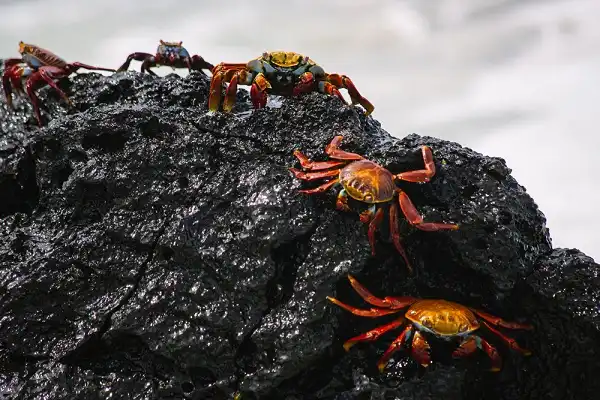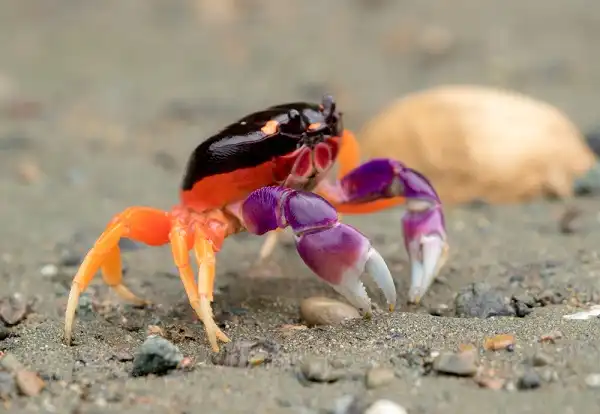Crabs are some of the most fascinating and highly intelligent invertebrates living in our oceans today. From the giant Japanese spider crab to small hermit crabs, these arthropods have adapted to an incredible range of aquatic conditions. Whether they inhabit warm tropical waters or Arctic seas, their synchronized movements as they navigate complex ocean environments are nothing short of miraculous. In this blog post, we will explore some remarkable facts about these curious crustaceans and learn more about their behavior and habitats.

Crab Description
Crabs are extraordinary and remarkable invertebrates that inhabit a wide range of aquatic environments. From the giant Japanese spider crab to small hermit crabs, these arthropods have adapted to incredibly diverse ocean conditions with great success. Their synchronized movements as they float through the water are truly astounding and captivating. Crabs are also highly intelligent creatures, with many types displaying complex social behaviors like cooperative hunting, problem-solving, and communication between members of their group. They come in a variety of sizes and colors that make them fascinating to observe in their natural habitats.
Crab Habitat
Crabs inhabit a wide range of both marine and freshwater habitats. They can be found in shallow waters such as estuaries, bays, and other coastal areas, as well as in deeper waters like the continental shelf and abyssal depths. They have also been spotted in Arctic and Antarctic locations, where temperatures can reach freezing levels. Crabs tend to live in places with abundant food sources, such as seagrass beds, coral reefs, kelp forests, and tidal flats. In addition to the ocean floor, some species of crabs are even able to climb trees and rocks near shorelines! The type of habitat chosen by a crab depends on its size, behavior, and defense strategies. While larger crabs tend to prefer open environments with plenty of hiding spots such as rock crevices or coral holes, smaller crabs need to find protection from predators by hiding in small burrows or underneath stones. Crabs also require access to food sources such as algae beds or sandy beaches where they can scavenge for morsels. Many kinds of crabs use their claws to construct elaborate dwellings that provide protection against currents, predators, and unfavorable conditions.
Crab Diet
Crabs have a varied diet that depends largely on the type of habitat in which they live. In tropical and subtropical waters, where there is typically plenty of food available, crabs feed mainly on algae and small invertebrates such as mollusks, worms, and crustaceans. Some species will also scavenge for larger pieces of organic matter like dead fish and other carcasses. In temperate waters, crabs tend to feed more heavily on algae, while at higher latitudes feeding activity decreases significantly due to colder temperatures and reduced availability of food sources. Some species of crabs are omnivorous, meaning they eat both plant and animal matter. Different types of crabs may also feed differently based on their size; smaller crabs are more likely to consume microscopic-sized organisms while larger crabs prefer bigger pieces of prey like clams or urchins. Many species will also supplement their diet with carrion or decaying material in order to get extra nutrition.

Crab Size
Crab size can vary greatly depending on the species and location. Some of the smallest crabs measure just a few millimeters in length while others can reach up to a foot or more across the widest point. As they grow, crabs often shed their exoskeleton and undergo several molts before reaching maturity. This process can take anywhere from weeks to months, depending on the species and environmental factors such as food availability and temperature. The size of a crab’s habitat also plays an important role when it comes to sizing up these animals. Generally speaking, crabs living in shallow waters tend to reach smaller sizes than those living in deeper waters due to the reduced availability of food sources and colder temperatures found at greater depths. Estuarine habitats also seem to promote larger sizes since these environments provide plenty of food for growth as well as protection from predators for many species of crab.
Crab Lifespan
Crabs have a wide range of lifespans, depending on the species and size. Generally speaking, smaller crabs tend to live shorter lives than larger ones. The average lifespan for most crab species is between 2 and 3 years, but some can reach up to 10 years or more in captivity. In the wild, however, their lifespan is often significantly shorter due to predation and other natural factors. In terms of individual growth rates, some species of crab can reach their full size in just a few weeks while others may take several months to reach maturity. Regardless of size, all crabs go through the same general life cycle which includes the molting process where they shed their exoskeleton multiple times as they grow larger. This process usually takes place at night and is triggered by fluctuations in water temperature or changes in food availability. Overall, crab lifespans depend heavily on environmental factors such as temperature, food availability, and predators. Additionally, some species may have longer lifespans than others due to genetic differences or adaptations that make them better suited for certain habitats or seasons. Nonetheless, these creatures are fascinating animals with unique lifestyles that greatly add to our understanding of marine ecosystems around the world.
Crab Behavior
Crabs are highly sociable creatures and can often be seen interacting with one another, whether it be for mating or just socializing. In general, they tend to live in colonies where they can scavenge for food and protect each other from predators. During the day, they search for food and shelter in intertidal areas, while at night they return to their hiding places in crevices or burrows to sleep. When threatened, crabs will either flee or defend themselves by using their claws or by releasing a noxious substance that can deter potential predators. Crabs also communicate with each other through a variety of behaviors such as waving their claws and drumming their shells with small stones. Crabs have complex courtship behaviors involving a variety of displays such as waving their claws and drumming on shells. When two crabs find a suitable mate, the male will stroke the female’s body with its antennae before attempting to mount her carapace. Then, if the female is receptive she will allow her mate to climb onto her back for mating.

Crab Speed
Crab speed can vary greatly depending on the species and their environment. In general, most crabs move quite slowly with an average walking speed of only 0.2 meters per second. However, some species can move at speeds up to 1 meter per second when startled or threatened by a predator. In addition, some crab species such as the fiddler crab are capable of hopping or running short distances in order to escape danger quickly. When swimming, crabs tend to reach higher speeds than when they are walking on land. Some species have been clocked at moving up to 5 meters per second underwater, allowing them to traverse large distances quite quickly despite their slow pace out of water. Crabs also use their powerful claws for propulsion and steering while swimming in order to navigate turbulent waters more easily. On land, crabs rely mainly on their legs for locomotion which helps them climb rocks and other obstacles in search of food or shelter more efficiently than their aquatic counterparts. Depending on the terrain and surface type, some crab species can even reach speeds up to 8 meters per second while running over short distances!
Crab Hunting
Crab hunting is the practice of capturing crabs from their natural habitats for either recreational or commercial purposes. Recreational crab hunters typically use traps and nets, while commercial fishermen may employ more advanced tactics such as dredging, trawling, and bottom trawling to capture large amounts of crabs at once. In terms of bait, most crab hunters will use raw chicken or fish heads and guts to attract the crabs into their traps or nets. Crab hunting is typically done in coastal areas where there are high concentrations of crabs. This can range from shallow areas close to the shoreline all the way out to deeper sea beds where many species of crabs can be found. Some popular locations for crab hunting include tidal flats, estuaries, mangroves, mudflats, rocky shores, and coral reefs. The practice of crab hunting has been around for centuries and continues to remain popular today. Not only is it a great way to spend time outdoors with friends and family but it also helps promote sustainability by keeping local crab populations from becoming overpopulated or depleted. Additionally, some states have regulations that require recreational crabbers to abide by size limits in order to protect juvenile crabs from being harvested too early in their development cycle.

Conclusion
Crabs are slow-moving creatures. They have adapted various behaviors that enable them to survive in their environments regardless of habitat type and seasonality. Additionally, crab hunting is a popular activity that helps promote sustainability by keeping local crab populations from becoming overpopulated or depleted. Overall, despite their natural handicap of being slower than most other animals, crabs have managed to thrive in many habitats around the world due to their intelligence, adaptability, and resourcefulness. This makes them one of nature’s most fascinating and resilient creatures!
Frequently Asked Question

